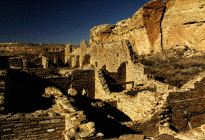A Brief history of Northern New Mexico Architecture
 What is known today as the “Santa Fe style” of architecture actually goes back more than 1,600 years. Such characteristics as stark, curving walls and earth-colored masonry can be traced directly to the Pueblo Indians and their forebears, who first made their homes in the Four Corners region before the birth of Christ. Built of stone or adobe on a decidedly human scale, the Indian settlements complimented nature by blending into the surrounding landscape. In this way, their architecture reflected not only their harmony with the earth but their reverence for the wholeness of life as well.
What is known today as the “Santa Fe style” of architecture actually goes back more than 1,600 years. Such characteristics as stark, curving walls and earth-colored masonry can be traced directly to the Pueblo Indians and their forebears, who first made their homes in the Four Corners region before the birth of Christ. Built of stone or adobe on a decidedly human scale, the Indian settlements complimented nature by blending into the surrounding landscape. In this way, their architecture reflected not only their harmony with the earth but their reverence for the wholeness of life as well.
The earliest southwest dwellings were probably simple holes dug in the ground by the Pueblo Indians’ ancestors, called the Anasazi, a Navajo word meaning “ancient ones.” A primitive farming people who grew corn and beans, the Anasazi dug these holes, or pit-houses, to a depth of one to six feet. In time, four free standing posts were added to support a roof, which typically consisted of a number of horizontal poles (the forerunners of today’s vigas) covered with brush, sticks, dirt or mud. Entry to the pit-house was often gained through a square opening in the roof — an opening that also served as a smoke hole for the fire pit that provided the dwelling with light and heat.
As the Anasazi evolved, they turned away from the pit-house and began building their homes directly on top of the ground, using layers of dried mud or of stones laid in adobe mortar. Even so, the pit-house idea would survive in the form of a ceremonial chamber known as the kiva — an extra large circular room built underground and used to this day by the Anasazis’ descendants for worship or for socializing.
The above-ground structures, called clan or surface houses, appeared singly at first and then in groups as the Anasazi families came to live side by side. Windowless and with flat roofs, these homes gradually gave way to clustered settlements built mainly of stone masonry with two or more stories, much like modern-day apartment complexes. Construction of these magnificent Anasazi dwellings reached a high point around 1050 to 1300 AD, when stone-and-adobe settlements flourished at places like Mesa Verde in Colorado and Chaco Canyon in northwestern New Mexico.
Working at Chaco with blocks of sandstone, broken loose with hammers from nearby cliffs, the Anasazi shaped refined rock-ledge communities alongside towering canyon walls, well above the flood plain. Rising to a height of 40 to 50 feet, Chaco was actually a network of 12 major Pueblos and hundreds of smaller sites, accommodating perhaps 7,000 people. The largest village, called Pueblo Bonito, had more than 30 kivas and at least 650 rooms, many of them no larger than 9 feet by 14 feet and less than 8 feet in height. Walls were 3 feet thick on the ground floor and only a foot in thickness on the top story; windows were small, high, and slit like. For privacy and protection, the Anasazi hung skins or blankets across the doorways, which typically featured raised sills and low lintels.
For some unknown reason, settlements like those at Chaco Canyon were abandoned over several generations, beginning around 1300. The inhabitants migrated to new living sites, many of them along the Rio Grande and its tributaries. The new communities were smaller and less durable than the cliff dwellings, the homes typically made not of rock but of the mixture of sun-hardened sand and clay called adobe. Later, the Indians would be introduced by the Spanish to a method of shaping the adobe into bricks. This technique was economical, and it provided good thermal mass and acoustical insulation.
The Indians’ new dwellings were often centered around an internal plaza — the homes themselves marked, as in earlier times, by flat, viga-style roofs and few window or door openings. The communities were usually made up of a series of these block or group units, some of them piled atop each other in irregular fashion, as at Taos Pueblo. Over time, the New Mexico pueblos took on other, more modern characteristics which were absorbed from Anglo culture. By the late 1800s, for example, glass windows and wooden doors could be seen in the pueblo at Zuni. Other developments would include the addition of covered fireplaces and Hispanic bancos, or low wooden benches, built into interior walls.